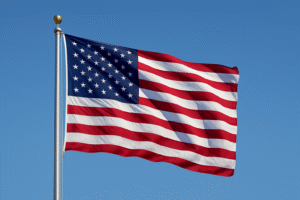
U.S. Flag Laws (2025):
The American flag is more than just a symbol of national pride—it is a legally protected emblem with specific rules governing its use, display, and handling. In 2025, while much of U.S. flag law remains rooted in tradition, evolving court interpretations and civic expectations make it crucial to understand what is legally required and what is considered respectful.
🏛️ Federal Law: The U.S. Flag Code
The primary source of guidance for flag handling is the U.S. Flag Code, found in Title 4 of the U.S. Code, Sections 1–10. While the Flag Code is not criminally enforceable, it provides a standardized framework for respectful flag use.
Key Flag Code Provisions (2025):
- The flag must never touch the ground or be used as clothing, bedding, or drapery.
- When displayed on a wall, the union (blue field of stars) should always be at the top left from the viewer’s perspective.
- No object, insignia, or lettering should be placed on the flag.
- It should only be displayed from sunrise to sunset unless illuminated during darkness.
These provisions are advisory, not legally binding. Violations do not result in penalties but may be met with social or institutional consequences.
🧑⚖️ Supreme Court Decisions on Flag Desecration
The most definitive legal statements on flag protection come from the U.S. Supreme Court:
- Texas v. Johnson (1989): Held that flag burning is protected speech under the First Amendment.
- United States v. Eichman (1990): Invalidated the federal Flag Protection Act of 1989 as unconstitutional.
Despite efforts to pass a constitutional amendment banning flag desecration, none have succeeded as of 2025. Thus, flag desecration remains legal, though socially controversial.
🏫 Flag Display in Schools and Government Buildings
Federal and state laws often mandate flag displays in certain settings:
- Public Schools: Most states require the Pledge of Allegiance and daily flag display. However, students cannot be compelled to participate, per the ruling in West Virginia State Board of Education v. Barnette (1943).
- Courthouses, Post Offices, and Government Facilities: The flag must be displayed daily, with exceptions for inclement weather unless an all-weather flag is used.
⚖️ Recent Developments (2025)
- Digital Displays: The Department of Veterans Affairs now recognizes virtual flag ceremonies as acceptable for remote federal observances.
- State-Specific Additions: States like Florida and Texas now impose civil penalties for using the flag in commercial advertising without permission.
- Flag Retirement Services: A rise in eco-friendly flag disposal programs sponsored by veterans’ groups and municipalities has grown significantly.
🇺🇸 Proper Flag Etiquette
While not enforceable, flag etiquette is deeply ingrained in U.S. civic culture:
- Stand and remove hats during the national anthem and flag-raising.
- Retire worn-out flags via burning in a dignified manner (many American Legion posts offer this service).
- Never display a damaged or soiled flag.
❓ FAQ
Q: Can I fly the American flag at night?
A: Yes, if it is properly illuminated during the hours of darkness.
Q: Is it illegal to burn the flag?
A: No. While it is offensive to many, the Supreme Court recognizes it as protected free speech.
Q: Can I put the flag on clothing or merchandise?
A: While not illegal, it is discouraged by the Flag Code, and some states may regulate it in commercial contexts.
🔗 Internal Links
🔗 External Links
- Flag Code—U.S. Code Title 4
- Texas v. Johnson (1989) Summary – Oyez
- American Legion Flag Retirement Info
Disclaimer: This article is for informational purposes only and does not constitute legal advice. Always consult a qualified attorney for guidance specific to your jurisdiction.